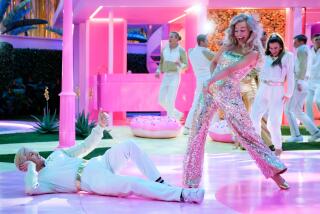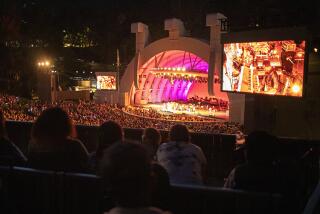Philip Glass to perform film, opera works at Hollywood Bowl

By the 1980s, Philip Glass had earned a healthy reputation working in the concert hall, art films and the theater. That didn’t mean he slid easily into Hollywood.
“When I first started doing Hollywood films,” Glass, 72, said by phone from his home in New York, “I was told I wasn’t writing real film music. I said, ‘What is real film music?’ And the person said, ‘It means you don’t remember the music.’ ”
“I said, ‘That’s such nonsense!’ When you think of ‘The Pink Panther,’ what do you think of? Hank Mancini! With ‘2001’ you think of Strauss -- the music goes right into your head! There are composers who can insinuate themselves into a film so you would not remember the film without the music.”
Real or not, Glass’ film music has helped make him perhaps the best-known classical composer of the last half-century. The three-time Academy Award nominee -- for “Kundun,” “The Hours” and “Notes on a Scandal” -- will bring his Philip Glass Ensemble to the Hollywood Bowl on Thursday to perform several of his important cinematic and operatic pieces with the L.A. Philharmonic.
Glass’ film music contrasts markedly with an earlier tradition of such composers as Erich Korngold and Bernard Herrmann: Rather than underscore or amplify a film’s emotions, his music’s tone remains strikingly neutral.
“It becomes a way of framing powerful imagery so you can have your own feelings about it -- at your own speed,” said Robert Fink, a UCLA musicology professor and author of “Repeating Ourselves: American Minimal Music as Cultural Practice.”
“He’s said that older film music is manipulative, like a commercial, with the music telling you how to feel, like propaganda. He has remained true to a pretty avant-garde idea.”
Putting it together
Glass came into film music in mid-career: He had already, with Terry Riley and Steve Reich, helped invent an American minimalism that grew out of the Western classical tradition and Indian music.
And he had already galvanized the art galleries, rock clubs and performance spaces of lower Manhattan with what he calls “music with repetitive structures,” served as assistant to sculptor Richard Serra, and produced (with director Robert Wilson) the breakthrough non-narrative opera from 1976, “Einstein on the Beach.”
But before film music became a central part of his career, the Baltimore-born Glass was still scrambling to hold things together financially. He formed, with Reich, the movers Chelsea Light Moving, and paid the bills before, during and after “Einstein” by driving a cab.
By the 1980s, his style established, he worked on increasingly large projects: Godfrey Reggio’s “Koyaanisqatsi,” an influential cult film; Paul Schrader’s “Mishima,” about the life and ritual suicide of Japanese novelist Yukio Mishima; and “The Thin Blue Line,” the first of several films with eccentric documentarian Errol Morris.
“I had a lot to learn, and I learned it very quickly,” Glass recalls. “The world of theater was the world I lived in -- not the world of the concert hall. So that made the entrance to film much easier, because I understood how things went together.”
Glass has collaborated with more artists from more genres -- including David Byrne, Aphex Twin and Woody Allen -- than perhaps any composer in history. From the beginning, he’s been conscious that his film scores need to fit another artist’s vision.
“The question is: What is the function of the music?” he asks. “What is it doing for the film?”
Each film answers the question a little differently: “ ‘The Hours’ was a complicated film -- it was set in three places at three different times, with inter-cutting between the three throughout the film.” Glass chose to use the same music in each section, showing that “the stories were really the same stories.”
In “Mishima,” the autobiographical sections about the author (shot in black and white) were accompanied by a string quartet, the scenes from his novels by an orchestra. On the last day of the writer’s life, the two styles come together, showing a convergence of his real and imaginative lives.
“Those are two films that caused tremendous challenges for the writers and the directors,” Glass says. “And the composer’s job, in my view, was to articulate the structure of the film. To make it viewable, to make sense of it.”
‘Koyaanisqatsi’s’ sound
Glass, who was raised Jewish in Baltimore, the son of a record store owner, has been a serious Buddhist for decades. Educated at the University of Chicago, Juilliard, and in Paris by the renowned Nadia Boulanger, he has been married four times and has four children and one grandchild. He’s well known on boards and groups that support Tibetan causes.
Many critics and musicians consider his last few decades a case of arrested development. In his recent memoir, “Hallelujah Junction,” composer John Adams describes Glass’ style as “largely unchanged over a period of nearly 40 years . . . in general I have had the feeling that he rarely troubles himself much with delving into new possibilities or combinations for the many different instruments that he writes for.”
But there is a solid consensus on the early Glass work to be performed at the Bowl on Thursday.
The main event is the Glass Ensemble playing the score to “Koyaanisqatsi” alongside the film -- something the group has done, by Glass’ estimate, 200 times. Glass, who plays keyboards with his ensemble, has written new parts for the Los Angeles Philharmonic, which will presumably thicken the music’s textures.
Working on that project for experimental documentarian Reggio highlighted for Glass the difference between an independent and studio film.
“The earlier you start on a film, the closer you’ll be aligned -- you can form a relationship around the artistic goals,” he says. “With independent films there’s often more time, because often the funding isn’t in place.”
With “Koyaanisqatsi” -- the name means “life out of balance” in Hopi -- Glass had more than two years to work on the score. “There was no one waiting for the film -- there was no distributor! So we were left alone to make a film -- which I realized later was a great luxury.”
Today Glass is struck by how pertinent the film seems, at a time when its notions of the world’s interconnectedness and the runaway power of technology have gone mainstream. But the film’s identity has changed since its premiere in 1982.
“When we first showed it,” he says, “people thought it was a head trip. People seriously thought you had to get high before you watched it. It wasn’t too long, only four or five years, for people to realize there was actually a movie.”
His opera in L.A.?
The other major Glass work that he’ll be performing at the Bowl is the brief “Spaceships” scene from “Einstein.” It’s a reminder that the celebrated opera itself -- one of the most important and groundbreaking American operas in history -- has never been performed in Los Angeles. But Glass himself is warily optimistic.
“We have real interested parties, and Wilson has gone back and done some new drawings. A lot of the groundwork has been laid. We’re getting close to that again -- but we’re in a moment when nobody has any money. If we don’t get to L.A. this time, I give up.”
The plight of “Einstein” shows something that might surprise laymen: Despite Glass’ fame and accomplishments, he still has trouble getting work staged.
His new opera on the life of 16th- and 17th-century German astronomer Johannes Kepler is scheduled to premiere in Linz, Austria, in September with no plans for a U.S. staging.
The future for his opera about Walt Disney is unclear, especially in the composer’s and animator’s native land. The opera was commissioned by New York City Opera, and is still in development but with the departure of then-incoming general director Gérard Mortier, it has no clear home.
“America’s a funny place,” Glass said. “It’s not impossible that the perfect American opera might not be put on here. Disney is the quintessential American story. I’m not slamming Disney at all” -- as some have claimed -- but trying to offer “a very complex view of a genius, on how someone’s vision could be so powerful that it could be known around the entire world.”
In some ways, then, doing any big-scale artistic endeavor is a little like working in Hollywood -- the combination of logistics, timing, ego, commerce and artistry.
“It didn’t surprise me,” Glass says of the roadblocks and frustrations he’s run into across his career. After all, he said, art fills a need that’s intangible and often unrequested.
“It’s always a struggle,” he said. “It’s like your aunts and uncles say: ‘Don’t complain, nobody asked you to do it.’ ”
More to Read
The biggest entertainment stories
Get our big stories about Hollywood, film, television, music, arts, culture and more right in your inbox as soon as they publish.
You may occasionally receive promotional content from the Los Angeles Times.






